More than 10,000 companies and businesses are now using Predictive Index Assessments to look for compatible individuals in their recruitment process. By looking at certain areas of prospective candidates, the assessments allow employers to make data-driven hiring decisions.
In this article, we’ll provide you with a comprehensive overview of the Predictive Index, two main types of Predictive Index Assessments, and sample questions for your practice.
Table of Contents
What is Predictive Index?
The Predictive Index (PI) is an award-winning talent optimization solution that adopts business strategy and people strategy for the best business results. It was founded by Arnold S. Daniels in 1955 and was known as PI Worldwide at that time.
The company specializes in providing assessments and tools for companies desiring to design great teams and working cultures, make data-driven hiring decisions, foster individual engagement, and inspire greatness in their people.
Predictive Index’s products have gone through multiple updates and today represent well-researched, business-relevant, and scientifically-proven assessments of behavioral tendencies in the workplace.
Over six decades have passed and now, thousands of organizations worldwide are now adopting The Predictive Index Assessment in nearly every job and industry.
What is a Predictive Index assessment?
Predictive Index (PI) Assessments consist of three different assessments, which are Predictive Index Job Assessment, Predictive Index Behavioral Assessment. and Predictive Index Cognitive Assessment.
The talent platform designs these assessments to help companies evaluate candidates in a science-proven way. In other words, PI assessments don’t focus solely on testing candidates’ performance on tasks and skills, but rather on the behavioral traits and cognitive abilities that will ensure a candidate will succeed in the new role.
Predictive Index Cognitive Assessment
The Predictive Index Cognitive Assessment (PICA) is a cognitive ability assessment that aims at measuring your cognitive ability and abstract intelligence needed for the role.
Various names of the PICA include:
- Common and past names of the PI Test
- Predictive index cognitive assessment
- PICA (PI Cognitive Assessment)
- Professional Learning Indicator Test (PLI Test)
- The PI Learning Indicator Test (PI LI Test)
- Predictive Index Test
Many companies adopt the PICA as an essential component of their recruitment process. It is often used as an indicator of trainability for positions at all levels of an organization. The PICA is available in 70+ languages and is a great assistance in accelerating onboarding and measuring an employee’s capacity to handle complex business situations.
A PICA consists of 50 multiple-choice questions covering different areas of evaluation, each containing its own subcategories. These areas include numerical, verbal, and abstract reasoning. Candidates will have a time limit of 12 minutes to finish the assessment.
As you take the test, each screen turn displays a total of 5 questions with the time running on the right side of it. You can do the questions in any order you wish using the ‘Previous’ and ‘Next’ buttons placed at the bottom of the page. You should take note that this assessment doesn’t allow calculators.
Numerical reasoning questions
In the subcategory of numerical reasoning questions, you will come across question types such as number series, math problems, and word problems.
For Number Series questions, you are required to work out the general rule among numbers in a given series and find the next missing number. This is to test candidates’ ability to logically reason with numbers.
Here’s an actual example for you.

Source: © The Predictive Index, 2022
Answer: 33
Explanation: By taking the difference between two adjacent numbers in the sequence, we can see that the common difference increases by one each time.
7 – 3 = 4
12 – 7 = 5
18 – 12 = 6
25 – 18 = 7
Our next term will fit the equation: x − 25 = 8, meaning that the next term must be 33.
For Math Problems, there will be a series of numbers or fractions and you are required to figure out what the lowest number in such a series is.
This is an example from a PICA sample.

Source: © The Predictive Index, 2022

For Word Problems, these are questions assessing your reading comprehension skills and numerical aptitude. Take the question below as an example.

Source: © The Predictive Index, 2022

Verbal reasoning questions
In the subcategory of verbal reasoning questions, there are questions about analogies, formal logic, and antonyms.
Analogies are word problems consisting of two different pairs of words with each word in each pair relating to each other in the same way. In an analogy question, you are presented with a pair of words, and a word in another pair. Your job is to work out the relationship in the given pair and adopt that rule for the other single word to find its missing word.
Here’s the example you need.

Source: © The Predictive Index, 2022
Answer: The correct answer is Vase.
Explanation: Water to cup describes the relationship between a thing and its container. Therefore Vase is the correct answer, as it is a container of Flowers.
In formal logic questions, you are given 2 to 3 assumptions with a conclusion. You will have to decide whether the conclusion is “Correct”, “Incorrect”, or “Cannot be determined based on the information available”.
Below is an example.
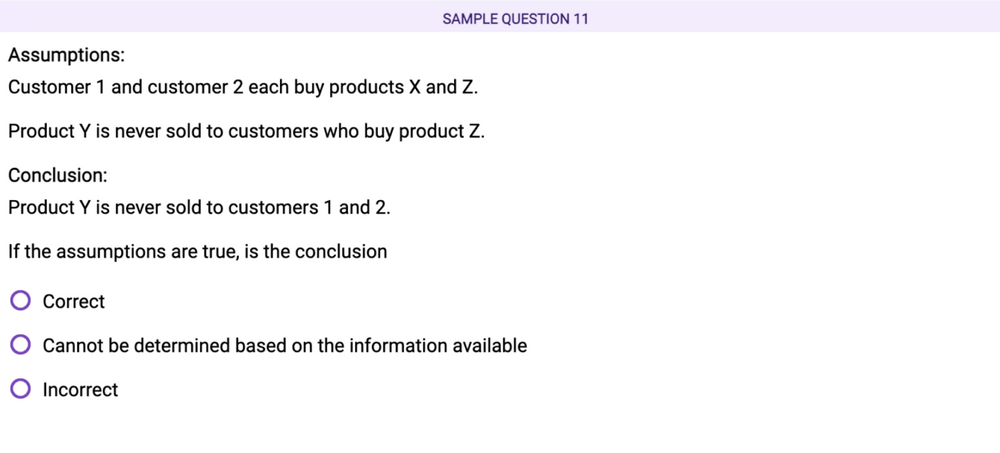
Source: © The Predictive Index, 2022
Answer: The correct answer is “Correct”
Explanation:
We first analyze the assumptions on the condition that they are true
Customer 1 and Customer 2, each buy product X and Z
⇒ Customer 1 buys two products: one X and one Z, and so does Customer 2.
⇒ Both customer 1 and 2 buys Z.
Since Y can never be sold to those who buy Z ⇒ Y can never be sold to Customer 1 and 2.
In antonym questions, you have to find the opposite word in meaning with the given word.
This is a question example.

Source: © The Predictive Index, 2022
Answer: The correct answer is restricted.
Abstract reasoning questions
In the subcategory of abstract or non-verbal reasoning questions, there are questions involving spatial awareness, logical reasoning, and inductive reasoning.
Spatial awareness questions provide you with 2 figures having something in common. You then have to decide which figure among 4 answer choices doesn’t have that same common feature.
For this question type, you try to look at only one aspect of a shape such as orientation, size, location, etc. at a time. This can help you determine what the common feature is.
This is an example for you.
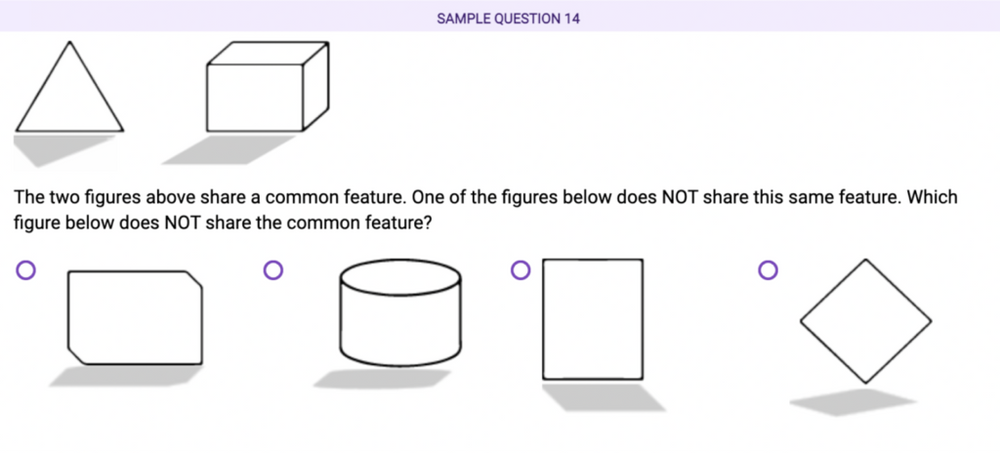
Source: © The Predictive Index, 2022
Answer: The correct answer is the third figure from the left.
Explanation: The two figures in the question all have their shade fall to the left side. Among the answer choices, only the third figure from the left doesn’t have its shade fall to the left side. Therefore, the correct answer is the third figure from the left.
In logical reasoning questions, you are presented with two pairs of images, with one pair describing a specific change. Your job is to determine that changing rule, and use it to find the missing image of the second pair.
Below is an example.
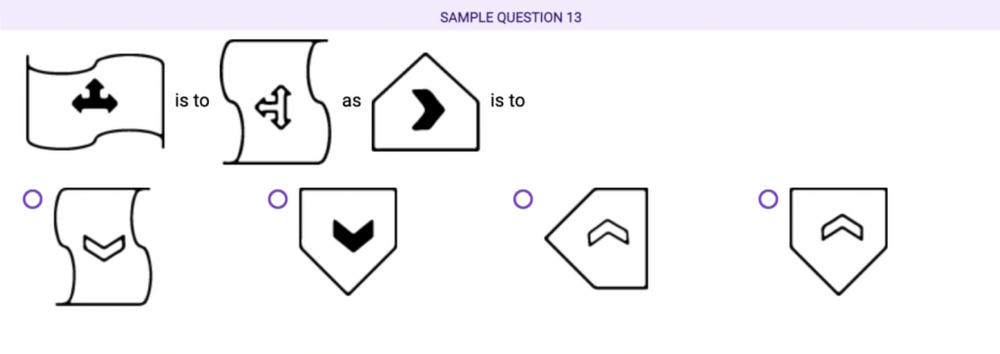
Source: © The Predictive Index, 2022
Answer: The correct answer is the third figure from the left.
Explanation: In the first pair, the first image rotates 90 degrees counterclockwise, and the symbol inside changes its color from black to white. Use the same logic with the first image in the second pair and we have the correct answer, which is the third image from the left.
For inductive reasoning questions, you will see a series of figures where you have to identify the rule or pattern behind them. Then you apply the same rule to determine the missing figure of this sequence.
Here is an example.
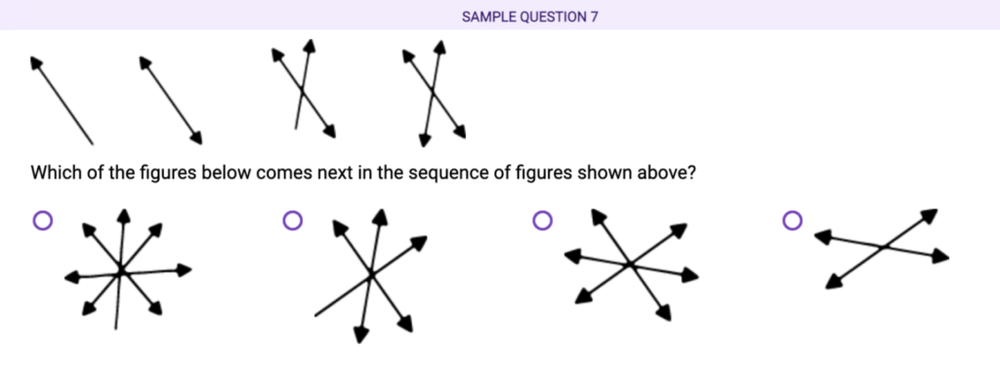
Source: © The Predictive Index, 2022
Answer: The correct answer is the second figure from the left.
Explanation: The rule behind this is you add a directional point to the arrow to make it a two-way arrow. Then each time you add a one-way arrow, you do the same thing. Therefore, the correct answer is the second figure from the left.
Predictive Index Cognitive scoring mechanism
Candidates will receive their scores immediately after finishing the assessment. Candidates will see their names on the left side and respective scores for each assessment area on the right. This is also known as the Predictive Index raw score.
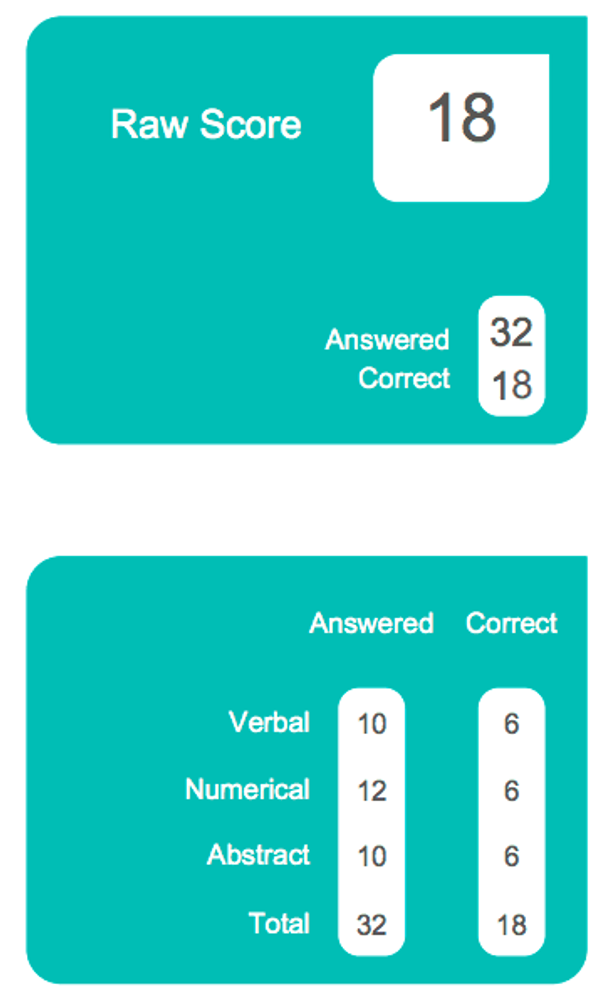
Predictive Index raw score. Source: © The Predictive Index, 2022
Unlike other cognitive ability assessments that use a percentile score system meaning to compare candidates against each other, the PICA is a criterion assessment. That means candidates are evaluated in comparison with a job target (criterion) rather than being compared against each other. Therefore, there are no “good” or “bad” scores with such a scoring system, but rather just how excellent you are at doing the tasks of the role.
Predictive Index uses norm groups, also known as representative samples, which is key to their assessments’ scientific validity. For the PICA, it is a sample comprising more than 288,000 assessment results representing an adult working population.
This representative group is used to set the threshold for the job function target scores in The Predictive Index’s Target Scoring Guide. It is also the reference for the normative plots in the PI Cognitive Assessment report for respondents.
While the PICA is a criterion-referenced assessment, it still uses assessment results of representative samples to develop job function mean scores in the Target Scoring Guide.
Predictive Index Behavioral assessment
The PI Behavioral Assessment is an assessment designed by the Predictive Index to help employers understand how prospective candidates might behave in the workplace. It is an untimed and stimulus-response assessment that collects valuable data about participants’ behaviors. Participants take around 6 minutes to finish this assessment.
The assessment presents candidates with two lists of adjectives. With the first list, candidates have to choose the words describing the way others expect them to act. With the second list, candidates are asked to select the words that self-reflect those individuals in their own opinion.
Each adjective in this assessment is associated with one of the four key factors determining people’s behavior within a workplace: dominance, extraversion, patience, and formality.
After finishing the test, candidates will receive the result called Reference Profile – a snapshot of the way they think and work.
The assessment is built to the standard of the American Psychological Association (APA), the Society for Industrial and Organizational Psychologists (SIOP), and the International Test Commission.
Which companies use Predictive Index assessments?
There is a great number of companies using The Predictive Index Cognitive Assessment in their pre-employment procedure. Popular names on the list include Maersk, Nestle, IKEA, Dell, and Microsoft.
For other Predictive Index Assessments, Predictive Index has more than 10,000 company clients across 90+ countries. This list includes big corporations and organizations such as Nissan, Citizens Bank, Subway, Blue Cross Blue Shield, and Omni Hotels.
Why practice PI assessments with MConsultingPrep?
The PI Assessment may seem like a major challenge for test-takers, especially when you have less than 1 minute for each question.
But it is no longer such a threat with our Aptitude Question Bank, you will soon tackle the assessment with confidence. Practicing regularly and strategically is the key to performing well on the Predictive Index Assessment.
By getting familiar with the test format, questions, time limit, and grading criteria, you better know your area of improvement. This is what sets you apart from other less prepared candidates.
MConsultingPrep’s practicing platform provides you with a structured guide and a library of practice tests for recruitment Aptitude Tests of all companies & businesses, including companies using Predictive Index Assessment.
Besides, you will also receive a comprehensive explanation upon finishing each question. These comprehensive answers will eventually help you leverage your test performance as you will not be making the same mistake AGAIN.
Our evaluation tools will record your scores and test times so you can have a better insight into your overall performance, what you excel at, and what you need more practice on.
/filters:quality(75)//case_thumb/public/1699589977462_aptitude_tests_package_4_x.png)